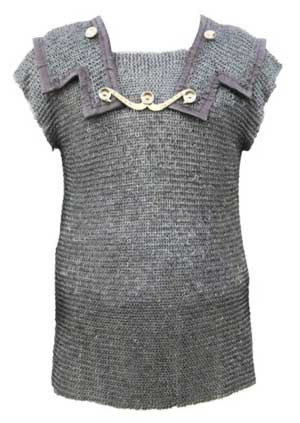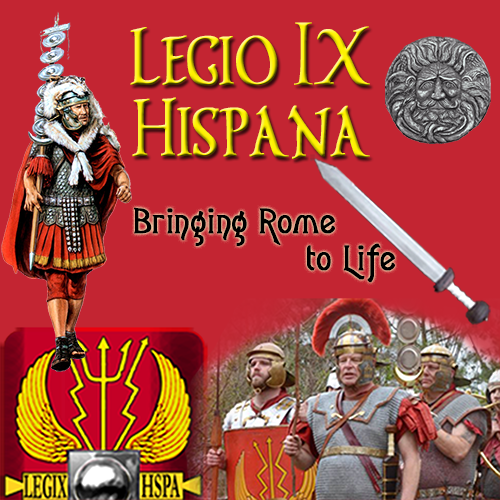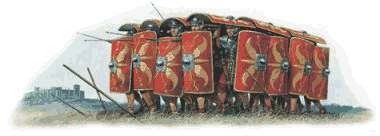Lorica Hamata (Chain Maile)
 The
lorica hamata, or maile, was the "standard" armor before the introduction of the lorica
segmentata, and it continued in use among auxiliaries and legionaries throughout the Imperial Period. It is
not known what the ratio of hamata to segmentata might have been in the mid-first century AD, but mail
shirts in the ranks is certainly acceptable, especially depending on the period of 1st Century impression a
member intends to portray. Mail was also worn by standard-bearers, musicians, and centurions, and of course
by auxiliary troops.
The
lorica hamata, or maile, was the "standard" armor before the introduction of the lorica
segmentata, and it continued in use among auxiliaries and legionaries throughout the Imperial Period. It is
not known what the ratio of hamata to segmentata might have been in the mid-first century AD, but mail
shirts in the ranks is certainly acceptable, especially depending on the period of 1st Century impression a
member intends to portray. Mail was also worn by standard-bearers, musicians, and centurions, and of course
by auxiliary troops.
A Long History
The hamata was used by soldiers of the Roman Republic and later, the Roman Empire. During the 1st century AD it was starting to be supplemented by lorica segmentata, but was reintroduced as sole standard-issue armour by the 4th century AD. It was issued to both primary legionary and secondary auxilia troops and was mostly manufactured out of bronze or iron.
The Romans' knowledge of mail manufacture may have come from Third Century BC conflicts with the Celts, though the first documented use occurred during the Roman conquest of Hispania. There were several versions of this type of armour, specialized for different military duties such as skirmishers, cavalry and spearmen.
Careful Design
The shoulders of the lorica hamata had flaps which ran from about mid-back to the front of the torso, and were connected by brass or iron hooks which connected to studs riveted through the ends of the flaps. Up to 30,000 rings might have gone into one lorica hamata, and the estimated production time was something like two months, even with continual slave labor at the state-run armouries.
A Good Design
Although labor-intensive to manufacture, it is thought that, with good maintenance, a hamata could be used for several decades. Constant friction kept the rings of the lorica hamata free of rust, unlike the lorica segmentata, which needed constant maintenance to prevent corrosion.
Over its lifetime, lorica hamata remained in constant use by legionaries and it was the preferred armour of centurions, who favored its greater coverage and lower maintenance. The lorica hamata was still common amongst the legionary soldiers in the 2nd century AD, despite the use of the more popularly recognized lorica segmentata segmented plate armour. Lorica segmentata was eventually discontinued in the third century AD for unknown reasons, but lorica hamata remained common for both legionaries and auxiliaries. Later versions had sleeves and covered the legs to the knees.
Details
Roman mail was generally made of iron, with rings as small as 1/8" in diameter, in the common "4 in 1" pattern. Usually, half the rings were solid--either punched from sheet metal, or cut from wire and welded shut--while the rest were riveted shut. The solid rings were roughly square in cross-section, i.e., the difference between the ring's inner and outer diameter was the same not much greater than the thickness. The wire for the riveted rings could be round (usually) or square. While it was long believed that some Roman mail rings may simply have been butted shut, closer analysis of surviving fragments has not revealed any definite proof of that. There is evidence that the rings could be tinned or even gilded!
It comprised alternating rows of closed washer-like rings punched from iron sheets and rows of riveted rings made from drawn wire that ran horizontally, producing very flexible, reliable and strong armour. Each ring had an inside diameter of about 5 mm, and an outside diameter of about 7 mm.
Fitting or Tailoring
There does not seem to be any direct evidence that the Romans "tailored" their mail, adding or subtracting rings from certain rows to shape the shirt. Since mail naturally conforms to the body, any hamata will fit a number of different-sized people, even without tailoring.











